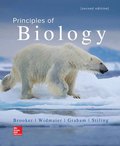
EBK PRINCIPLES OF BIOLOGY
2nd Edition
ISBN: 8220103675338
Author: BROOKER
Publisher: YUZU
expand_more
expand_more
format_list_bulleted
Textbook Question
Chapter 6.2, Problem 2TYK
An inhibitor raises the Km for an enzyme but has no effect on the Vmax. This inhibitor probably binds to
- the active site.
- an allosteric site.
- the substrate.
- all of the above.
- both a and b.
Expert Solution & Answer
Want to see the full answer?
Check out a sample textbook solution
Students have asked these similar questions
Explain in a small summary how:
What genetic information can be obtained from a Punnet square? What genetic information cannot be determined from a Punnet square?
Why might a Punnet Square be beneficial to understanding genetics/inheritance?
In a small summary write down:
Not part of a graded assignment, from a past midterm
Chapter 6 Solutions
EBK PRINCIPLES OF BIOLOGY
Ch. 6.1 - Which do you think has more entropy, an NaCl...Ch. 6.1 - Prob. 1TYKCh. 6.1 - Prob. 2TYKCh. 6.2 - Prob. 1CCCh. 6.2 - Prob. 2CCCh. 6.2 - Prob. 3CCCh. 6.2 - Prob. 1TYKCh. 6.2 - An inhibitor raises the Km for an enzyme but has...Ch. 6.3 - Prob. 1CCCh. 6.3 - Prob. 1TYK
Ch. 6.3 - Prob. 2TYKCh. 6.3 - Prob. 3TYKCh. 6.4 - Prob. 1CCCh. 6.4 - Prob. 1BCCh. 6.4 - Prob. 1TYKCh. 6.4 - Prob. 2TYKCh. 6.4 - Prob. 2CCCh. 6.5 - Prob. 1TYKCh. 6.6 - During the citric acid cycle, what happens to...Ch. 6.7 - Prob. 1CCCh. 6.7 - Prob. 2CCCh. 6.7 - Prob. 3CCCh. 6.7 - Prob. 1TYKCh. 6.7 - Prob. 2TYKCh. 6.7 - Prob. 3TYKCh. 6.8 - Prob. 1CCCh. 6.8 - Prob. 1TYKCh. 6 - According to the second law of thermodynamics....Ch. 6 - Reactions that release free energy are exergonic....Ch. 6 - Prob. 3TYCh. 6 - Prob. 4TYCh. 6 - Prob. 5TYCh. 6 - Prob. 6TYCh. 6 - Prob. 7TYCh. 6 - Prob. 8TYCh. 6 - Prob. 9TYCh. 6 - Prob. 10TYCh. 6 - Describe the mechanism and purpose of feedback...Ch. 6 - What causes the rotation of the y subunit of ATP...Ch. 6 - PRINCIPLES A principle of biology is that living...Ch. 6 - Discuss how life can maintain its order in spite...Ch. 6 - Prob. 2CBQ
Knowledge Booster
Learn more about
Need a deep-dive on the concept behind this application? Look no further. Learn more about this topic, biology and related others by exploring similar questions and additional content below.Similar questions
- Noggin mutation: The mouse, one of the phenotypic consequences of Noggin mutationis mispatterning of the spinal cord, in the posterior region of the mouse embryo, suchthat in the hindlimb region the more ventral fates are lost, and the dorsal Pax3 domain isexpanded. (this experiment is not in the lectures).a. Hypothesis for why: What would be your hypothesis for why the ventral fatesare lost and dorsal fates expanded? Include in your answer the words notochord,BMP, SHH and either (or both of) surface ectoderm or lateral plate mesodermarrow_forwardNot part of a graded assignment, from a past midtermarrow_forwardNot part of a graded assignment, from a past midtermarrow_forward
- please helparrow_forwardWhat does the heavy dark line along collecting duct tell us about water reabsorption in this individual at this time? What does the heavy dark line along collecting duct tell us about ADH secretion in this individual at this time?arrow_forwardBiology grade 10 study guidearrow_forward
arrow_back_ios
SEE MORE QUESTIONS
arrow_forward_ios
Recommended textbooks for you
 Human Biology (MindTap Course List)BiologyISBN:9781305112100Author:Cecie Starr, Beverly McMillanPublisher:Cengage Learning
Human Biology (MindTap Course List)BiologyISBN:9781305112100Author:Cecie Starr, Beverly McMillanPublisher:Cengage Learning Biology Today and Tomorrow without Physiology (Mi...BiologyISBN:9781305117396Author:Cecie Starr, Christine Evers, Lisa StarrPublisher:Cengage Learning
Biology Today and Tomorrow without Physiology (Mi...BiologyISBN:9781305117396Author:Cecie Starr, Christine Evers, Lisa StarrPublisher:Cengage Learning Biology (MindTap Course List)BiologyISBN:9781337392938Author:Eldra Solomon, Charles Martin, Diana W. Martin, Linda R. BergPublisher:Cengage Learning
Biology (MindTap Course List)BiologyISBN:9781337392938Author:Eldra Solomon, Charles Martin, Diana W. Martin, Linda R. BergPublisher:Cengage Learning Biology: The Dynamic Science (MindTap Course List)BiologyISBN:9781305389892Author:Peter J. Russell, Paul E. Hertz, Beverly McMillanPublisher:Cengage Learning
Biology: The Dynamic Science (MindTap Course List)BiologyISBN:9781305389892Author:Peter J. Russell, Paul E. Hertz, Beverly McMillanPublisher:Cengage Learning Concepts of BiologyBiologyISBN:9781938168116Author:Samantha Fowler, Rebecca Roush, James WisePublisher:OpenStax College
Concepts of BiologyBiologyISBN:9781938168116Author:Samantha Fowler, Rebecca Roush, James WisePublisher:OpenStax College

Human Biology (MindTap Course List)
Biology
ISBN:9781305112100
Author:Cecie Starr, Beverly McMillan
Publisher:Cengage Learning

Biology Today and Tomorrow without Physiology (Mi...
Biology
ISBN:9781305117396
Author:Cecie Starr, Christine Evers, Lisa Starr
Publisher:Cengage Learning

Biology (MindTap Course List)
Biology
ISBN:9781337392938
Author:Eldra Solomon, Charles Martin, Diana W. Martin, Linda R. Berg
Publisher:Cengage Learning

Biology: The Dynamic Science (MindTap Course List)
Biology
ISBN:9781305389892
Author:Peter J. Russell, Paul E. Hertz, Beverly McMillan
Publisher:Cengage Learning

Concepts of Biology
Biology
ISBN:9781938168116
Author:Samantha Fowler, Rebecca Roush, James Wise
Publisher:OpenStax College

Haematology - Red Blood Cell Life Cycle; Author: Armando Hasudungan;https://www.youtube.com/watch?v=cATQFej6oAc;License: Standard youtube license